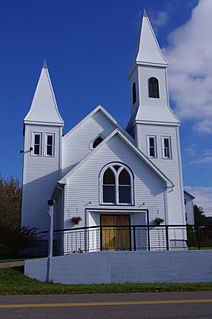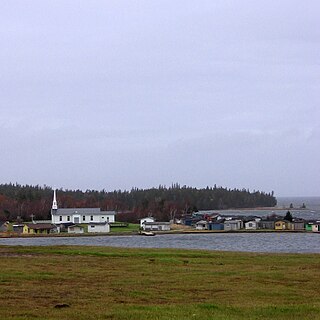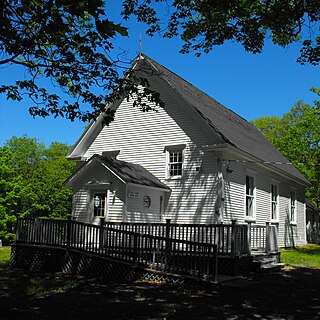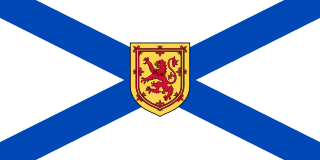The Eskasoni First Nation is a band government of the First Nations indigenous Mi'kmaq people located in Nova Scotia, Canada. As of 2012, the Mi'kmaq population is 3,490 on-Reserve, and 592 off-Reserve. It is the most populous band government in Nova Scotia and has its own community radio station, CICU-FM, broadcasting at 94.1 MHz. The Eskasoni First Nation is the home of the Unama'ki Institute of Natural Resources, a Mi'kmaq organization devoted to natural resources and the environment.

Whycocomagh is a Canadian rural community in the province of Nova Scotia. The population in 2001 was 854 residents. It is located on the eastern edge of Inverness County in the central part of Cape Breton Island. The community sits on the northwestern shore of St. Patrick's Channel, an arm of Bras d'Or Lake. Whycocomagh (We'koqma'q) is a Mi'kmaq word which means "Head of the Waters." Nearby is a Mi'kmaq reserve where wooden sculptures and baskets are made.
The Membertou First Nation is a Mi'kmaq First Nation band government in the tribal district of Unama'ki, also known as Cape Breton Island, Nova Scotia. As of 2012, the Mi'kmaq population is 814 on-Reserve, and approximately 481 off-Reserve. It operates a community radio station CJIJ-FM.

The Potlotek First Nation, also known as Chapel Island First Nation is a Mi'kmaq First Nation in northeastern Nova Scotia. The First Nation is situated on the Chapel Island 5 reserve on Chapel Island in Bras d'Or Lake. As of 2012, the First Nation has 521 members living on-reserve, and approximately 127 off-reserve.

Indian Brook 14 is a Mi'kmaq reserve located in Hants County, Nova Scotia. In the 2016 Census, the reserve has 1,089 residents.

The St. Croix River is a river in Nova Scotia entirely contained in Hants and Halifax Counties. Its headwaters are Panuke Lake. The river has been exploited for water power. There were water mills in the nineteenth century and in the 1930s three hydroelectric dams were built; they still operate.

Bear River First Nation is a Míkmaq First Nations band government located in both Annapolis County and Digby County, Nova Scotia. As of 2012, the Mi'kmaq population is 103 on-Reserve, and approximately 211 off-Reserve.

Eskasoni 3 is a Mi'kmaq reserve located in Cape Breton County, Nova Scotia.

Pictou Landing First Nations is a Mi'kmaq First Nation band government in Nova Scotia, Canada. Their territory spans five reserves that have a combined area of 527.6 hectares. As of September 2017, the Mi'kmaq population is 485 on their own reserve, 23 on other reserves and 157 living off-reserve.

Pomquet and Afton 23 is a Mi'kmaq reserve located in Antigonish County, Nova Scotia.

Summerside 38 is a Mi'kmaq reserve located in Antigonish County, Nova Scotia.

Whycocomagh 2 is a Mi'kmaq reserve located in Inverness County, Nova Scotia.
The Acadia First Nation is composed of five Mi'kmaq First Nation reserves located in southwestern Nova Scotia. As of 2015, the Mi'kmaq population is 223 on-Reserve, and 1,288 off-Reserve. Acadia First Nation was founded in 1967 and covers the south shore area of Nova Scotia and Yarmouth County. The community runs multiple businesses including 5 gaming centres, 3 gas stations, and a resource company.
Wagmatcook First Nation is a band of Mi'kmaq people located in Cape Breton Island, Nova Scotia. As of 2017, the registered population was 537 on their on reserve.

Franklin Manor 22 is a Mi'kmaq reserve located in Cumberland County, Nova Scotia. The community is named after Nova Scotia Governor Michael Francklin, who spoke Mi'kmaq and whose funeral was attended by hundreds of Mi'kmaq.
Annapolis Valley First Nation is composed of two Mi'kmaq First Nation reserves located in southwestern Nova Scotia. As of 2017, the Mi'kmaq population is 119 on-Reserve, and approximately 173 off-Reserve for a total population of 292. The community has a gas bar, tobacco shop, gaming centre, health centre, and a chapel. It is the second smallest First Nation community in Nova Scotia in terms of population.

The Sipekne'katik First Nation is composed of four Mi'kmaq First Nation reserves located in central Nova Scotia. As of 2012, the Mi'kmaq population is 1,195 on-Reserve, and approximately 1,190 off-Reserve. The First Nation includes Indian Brook 14, Nova Scotia, near Shubenacadie, Nova Scotia. The band was known as the Shubenacadie First Nation until 2014 when the traditional spelling and pronunciation of its name was officially adopted.

Waycobah First Nation is composed of two Mi'kmaq Indian Reserves located in Cape Breton Island, Nova Scotia. As of 2012, the Mi'kmaq population is 833 on-Reserve, and approximately 82 off-Reserve.

The Mic-Mac hockey stick was made originally by the Mi'kmaq people of Nova Scotia, who dominated the international ice hockey market in the early twentieth century. It was first marketed by the Starr Manufacturing Company of Dartmouth, Nova Scotia, in the 1860s.
The Confederacy of Mainland Mi'kmaq is a Tribal Council in Nova Scotia, Canada. It was incorporated in 1986 and has its main office at Millbrook First Nation. It delivers community programs and advisory services to its members. It has seven member communities; Annapolis Valley, Bear River, Glooscap, Millbrook, Paq'tnkek, Pictou Landing and Sipekne'katik.










